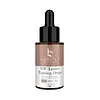What's inside
What's inside
 Key Ingredients
Key Ingredients

No key ingredients
 Benefits
Benefits

 Concerns
Concerns

No concerns
 Ingredients Side-by-side
Ingredients Side-by-side

Water
Skin ConditioningDihydroxyacetone
Skin ConditioningAloe Barbadensis Leaf Juice
Skin ConditioningEthoxydiglycol
HumectantGlycerin
HumectantCamellia Sinensis Leaf Extract
AntimicrobialLitchi Chinensis Fruit Extract
Skin ConditioningEuterpe Oleracea Fruit Extract
Saccharum Officinarum Extract
MoisturisingJuglans Nigra Leaf Extract
AstringentSodium Hyaluronate
HumectantSodium Metabisulfite
AntioxidantCaprylyl Glycol
EmollientPhenethyl Alcohol
MaskingCaprylyl Glucoside
CleansingCocamidopropyl Betaine
CleansingMaltodextrin
AbsorbentAlcohol
AntimicrobialCaramel
Cosmetic ColorantCI 14700
Cosmetic ColorantCI 19140
Cosmetic ColorantBlue 1 Lake
Cosmetic ColorantParfum
MaskingWater, Dihydroxyacetone, Aloe Barbadensis Leaf Juice, Ethoxydiglycol, Glycerin, Camellia Sinensis Leaf Extract, Litchi Chinensis Fruit Extract, Euterpe Oleracea Fruit Extract, Saccharum Officinarum Extract, Juglans Nigra Leaf Extract, Sodium Hyaluronate, Sodium Metabisulfite, Caprylyl Glycol, Phenethyl Alcohol, Caprylyl Glucoside, Cocamidopropyl Betaine, Maltodextrin, Alcohol, Caramel, CI 14700, CI 19140, Blue 1 Lake, Parfum
Aloe Barbadensis Leaf Juice
Skin ConditioningDihydroxyacetone
Skin ConditioningGlycerin
HumectantErythrulose
TanningAcetyl Tyrosine
Skin ConditioningPersea Gratissima Oil
Skin ConditioningSimmondsia Chinensis Seed Oil
EmollientSqualane
EmollientCucumis Sativus Fruit Extract
EmollientChamomilla Recutita Flower Extract
MaskingCalendula Officinalis Flower Extract
MaskingCamellia Sinensis Flower Extract
PerfumingPunica Granatum Extract
AstringentVanilla Planifolia Fruit Extract
Skin ConditioningLactobacillus Ferment
Skin ConditioningCocos Nucifera Fruit Extract
EmollientPropanediol
SolventZinc Ricinoleate
Xanthan Gum
EmulsifyingCitric Acid
BufferingAloe Barbadensis Leaf Juice, Dihydroxyacetone, Glycerin, Erythrulose, Acetyl Tyrosine, Persea Gratissima Oil, Simmondsia Chinensis Seed Oil, Squalane, Cucumis Sativus Fruit Extract, Chamomilla Recutita Flower Extract, Calendula Officinalis Flower Extract, Camellia Sinensis Flower Extract, Punica Granatum Extract, Vanilla Planifolia Fruit Extract, Lactobacillus Ferment, Cocos Nucifera Fruit Extract, Propanediol, Zinc Ricinoleate, Xanthan Gum, Citric Acid
 Reviews
Reviews

Ingredients Explained
These ingredients are found in both products.
Ingredients higher up in an ingredient list are typically present in a larger amount.
Aloe Barbadensis Leaf Juice comes from leaves of the aloe plant. Aloe Barbadensis Leaf Juice is best known for helping to soothe sunburns. It is also anti-inflammatory, moisturizing, antiseptic, and can help heal wounds.
Aloe is packed with good stuff including Vitamins A, C, and E. These vitamins are antioxidants, which help fight free-radicals and the damage they may cause. Free-radicals are molecules that may damage your skin cells, such as pollution.
Aloe Barbadensis Leaf Juice also contains sugars. These sugars come in the form of monosaccharides and polysaccharides, folic acid, and choline. These sugars are able to help bind moisture to skin.
It also contains minerals such as calcium, 12 anthraquinones, fatty acids, amino acids, and Vitamin B12.
Learn more about Aloe Barbadensis Leaf JuiceDihydroxyacetone, or DHA, is a simple sugar. It is frequently used in self-tanning products.
DHA binds to the amino acids in your dead skin cells to create a brown/orange color. Darkening begins to kick in a few hours after application and will continue to develop for up to 3 days. This ingredient can be drying.
Both the US and the EU have approved DHA in self-tanning products. In the EU, DHA is allowed at a maximum concentration of 10%. Most tanning products usually contain amounts between 3-5%.
If you are pregnant or have underlying medical conditions, it is best to speak with a dermatologist about using self-tanning products.
Learn more about DihydroxyacetoneGlycerin is already naturally found in your skin. It helps moisturize and protect your skin.
A study from 2016 found glycerin to be more effective as a humectant than AHAs and hyaluronic acid.
As a humectant, it helps the skin stay hydrated by pulling moisture to your skin. The low molecular weight of glycerin allows it to pull moisture into the deeper layers of your skin.
Hydrated skin improves your skin barrier; Your skin barrier helps protect against irritants and bacteria.
Glycerin has also been found to have antimicrobial and antiviral properties. Due to these properties, glycerin is often used in wound and burn treatments.
In cosmetics, glycerin is usually derived from plants such as soybean or palm. However, it can also be sourced from animals, such as tallow or animal fat.
This ingredient is organic, colorless, odorless, and non-toxic.
Glycerin is the name for this ingredient in American English. British English uses Glycerol/Glycerine.
Learn more about Glycerin